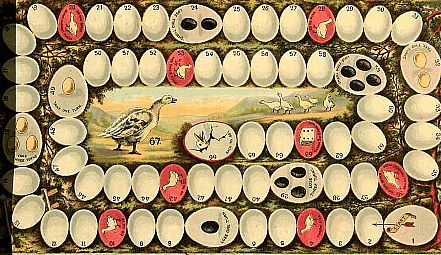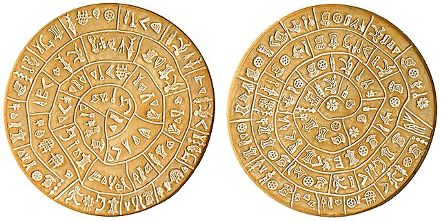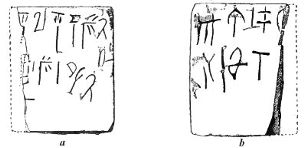The Phaistos Disc
Puzzle of Crete

|
Solutions Many people have claimed to have solved the mystery of the disc, but none of them have really been proven beyond doubt. The main reason for that is because without a larger body of text to compare to, there is no means of testing the theories. Some of the signs are close enough to Linear A and its translated counterpart, Linear B, that some scholars believe they might have the same phonetic values. One theory is that the disc is a calendar system. One side has 12 words, each ending in a disk-helmet combination, which could depict the twelve months. The words between those could denote special events, such as changing of seasons, or dates. The other side has just a single word ending with the disk-helmet combination and the side is divided into 30 words, which could represent the days of a month. One obvious complaint about this proposed solution is whether something almost four-thousand years old would confirm so closely to our modern idea of a calendar. Nonetheless, a number of people have latched onto this theory. The dissension between them seems to be how its interpreted. While some have thought the extra symbols and words among the months would be natural events, like a farmer's almanac, others have claimed that the images describe ceremonies or duties that should be performed on specific dates. It has even been proposed that the disc is a schedule is for palace activities.  A version of "Game of the Goose", which might have descended from the Phaistos Disc Another strong idea is that it is some kind of puzzle or game board. It does have some traits with Egyptian games which track the sun god and moon goddess, both astronomically and mythologically. Another game it could be related to is known as "Game of the Goose". This is a board game played on a spiral with numbered space, usually 63, with the starting point on the outside. The players move pieces according to the throw of dice. The name comes from the depictions of a goose that are scattered throughout the board. Landing on such a character allows the player to move again the same distance. Other symbols can cause a player to move to other positions, move backwards, or lose a turn. Some believe the "Game of the Goose" could have been derived from the game on the disc. The proposal of it being a puzzle can be shown by connecting identical symbols to see patterns, much the same as a connect-the-dot puzzle of modern day. Each group of these connections is alleged to depict something specific. One of these images is said to be the cave where the Nimrud lens, the oldest discovered lens in the world, was found. Another image is purported to be an image of the constellation Argo. Other images might depict the star Sirius in the center of seven planets and one of the the Great Pyramids. A few problems with this conclusion exist, though. First, a simple drawing consisting of straight lines to points can't be accurate enough to be a single item. It's similar to an ink blot test, in which the observer is asked what they see. The way the dots are connected to make these drawings vary, as if the person is forcing a specific image to be there. For example, the cave is "found" by connecting three circles, one inside the other. However, the drawing for the pyramid only appears by connecting five dots directly to a single top dot. If the pyramid dots are connected in any other way, the image is completely different. Another problem is the randomness of these images. Just from the four listed, two refer to astronomical occurrences, one to a man-made structure, and one to a location, a cave. The person or persons that made the disc would have to have knowledge of all those things. That brings us to a third problem: why? Why would someone go through so much trouble to produce a hidden depiction of unrelated items?  Copy of the disc, showing both sides A commercially available explanation of the Phaistos Disc became available in 1997 when Steven Roger Fischer published his book "Glyphbreaker". In it, Fischer to claims to have cracked the code of the disc, explaining that it is actually a call to arms, to repel the Carians, invaders from Anatolia, written in some form of ancient Greek. This is produced first by an assumption at what each symbol means as a syllable, then this basic decoding is "cleaned up" to what might be Greek. This cleaned Greek is then decoded. And example of this is a series of words being "e-qe ku-ri-ti, / de-ni qe, / ma pa-si / ma ma-pi. ". This can then be made into more proper Greek as "Ekue, Kurwitis Deneoi-que: ma pasis, ma mapoi" which could translate as "Hear ye, Cretans and Greeks: my great, my quick!". The entire translation would then go as: 'Hear ye,Cretans and Greeks: my great, my quick! He ye, Danaidans, the great, the worthy! Hear ye, all blacks, and hear ye, Pudaan and Libyan immigrants! Hear ye, waters, yea earth: Hellas faces battle with the Carians. Hear ye all! Hear ye, Gods of the Fleet, aye hear ye all: faces battle with the Carians. Hear ye all! Hear ye, the multitudes of black people and all! Hear ye, lords, yea freeman: Hear ye, Lords of the Fleet: To Naxos!' 'Hear ye, ye immigrants, the great and the small; ye countrymen skilled, most stalwart; lords Idaian; all Cretans: Strike ye out with the Greeks and smite the Carians, mine enemy, and succor my stricken. Safeguard me, Idaians: I am sore afraid. Loose me now. My night, my great: Ye loose me now. These afflictions so terrible and so great, verily so molestful: Ye loose me now. Down to the sea, everyone! Yea, deliver me of my great afflictions!' Some have credited this as being the true solution, while others view it to be far too many assumptions to be factual. This is because a general problem with decoding bodies of text is the lack of checks to eliminate bad assumptions. With a short text like that on the Phaistos Disk, if you make enough assumptions you can get a legible text in whatever language you want. But perhaps the biggest problem with this solution is that the Carians didn't appear in the Mediterranian region until a few thousand years after the disc was created. Besides claims of the text being in some form of Greek or Luwian, it has also been proposed by Sergei V. Rjabchikov that both Linear A and the disk are some unknown Slavonic language. He also says the disc signs are a decorative version of Linear A script. Adam Martin suggests the disc is actually bilingual, with one side being the text for a funeral service in Greek, and the other side is a Minoan version of the same text.  Drawings of the tablet found near the Phaistos Disc. The writing is Linear A, which might be related to the writing on the disc. Hedwig Roolvink claims she too has translated the disc, and that is describes the expedition of mountain people in their efforts to find a new place to settle. Kevin and Keith Massey claim it is in a Greek dialect, and that the disc is a receipt for goods, which would then have been destroyed. There are even suggestions that the disc was created by extraterrestrials that visited the Earth in ancient times. The list of possible solutions continues on, with over sixty published explanations already. None have gained widespread acceptance, and most conflict with all other claims. Hoax? Naturally, with no decipherment found, many people have speculated that the Phaistos Disc is a hoax. Most scholars believe that it is valid, though, especially given its connection to other proven writing systems of the time as well as its proximity to similar artifacts, such as a tablet in Linear A. Conclusion After one hundred years of speculation, people still are working to crack the meaning of the Phaistos Disc. One of the proposed solutions may be correct but unverifiable. It may also forever remain a mystery. What it does tell us that we still have so much more to learn about our ancient languages. |
| The Phaistos Disc - Puzzle of Crete | ||||||||||||||||||
| Writer: | Lucille Martin | |||||||||||||||||
| Images: | ||||||||||||||||||
| ||||||||||||||||||
| Sources: | ||||||||||||||||||
| ||||||||||||||||||
All images are Copyright - CC BY-SA (Creative Commons Share Alike) by their respective owners, except for Petey, which is Public Domain (PD) or unless otherwise noted.
comments powered by Disqus



















